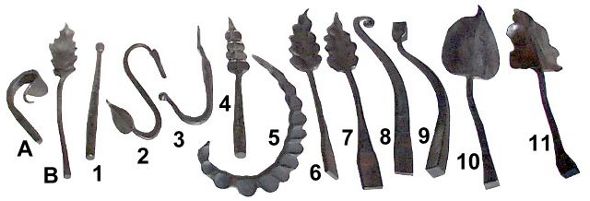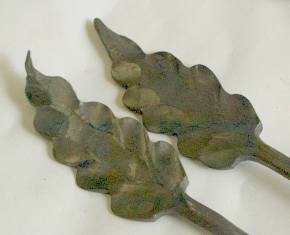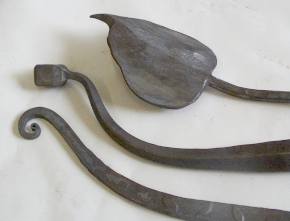|
||||
|
||||
|
||||
 |
||||

|
Elements #6 and #7
were forged from 1/4" x 1-1/2" flat bar.
These were forged by pointing and necking the flat bar with the combo dies then working with the crown dies.
The crown dies were first used to slightly thin the center of the leaf swelling the middle and giving it a rounder shape.
Then the crown dies were used to pinch the edges exactly like using your fingers to pull the edges out.
This was one of the most interesting of the elements. Using the rounded crown dies produced a fully three dimensional object with almost the same texture on both sides. The uniqueness of this is that while the part looks hand forged it does not have the flat back side typical of many hand forged parts. |
|||
 Top to bottom, Elements 10, 9 and 8
As the stock became heavier the work became more interesting.
Element #11 an "oak" leaf was an experiment that did not turn out well.
But it shows the possibilities.
Top to bottom, Elements 10, 9 and 8
As the stock became heavier the work became more interesting.
Element #11 an "oak" leaf was an experiment that did not turn out well.
But it shows the possibilities.
|
Element 8
was a combination of texturing and forging a taper and scroll.
The texturing was accomplished by striking the bar at the center of the combination dies bridging both the wide and narrow areas then fliping the bar to make another imprint next to the first.
With very little effort a flat but very forged look was given the bar.
Element #9 was forged from 1" (24.5mm) square bar. A block was isolated on the end and then the bar tapered. Elements #10 and #11 are leaves forged from 1" square bar. A bud is first formed exactly like hand forging a leaf, then using crown dies the leaf is spread sideways. The crown dies are so efficient in their directional shaping that a theoretical 1/4" thick by 4" width can be created. |
|||
|
For me this was sort of a busman's holiday. I went to this school to enjoy myself more than to learn new methods.
Although I have not produced a large quantity of work using power hammers I have used a great variety machines ranging from badly out of tune Little Giants in sizes 25 to 100 pounds, 100 lb Fairbanks, 300 pound Bradleys, 1B and 3B Nazels and 500 pound Chambersburgs.
I've also had the opportunitity to observe at length some of the wizards of the power hammer including my friend Josh Greenwood, Dan Boone and recently Uri Hofi.
Those of you that know me know that I do not have to observe a mechanical technique more than once to understand its value and use.
Although I was very out of practice on the hammer, a week in my own shop would have me back in true form.
But I did learn a few things (besides how out of practice I was).
All the hammers I've seen or run had different shaped dies ranging from flat and various combos to slightly crowned. Although none were as flexible and as well thought out as these they all had advantages and disadvantages. In the shops where there was more than one hammer they would often be used on one piece during one or more heats the smith moving from hammer to hammer mostly to take advantage of the different dies more than the difference in size or type of hammer. I have seen several smiths that worked two hammers from one forge for one smith. In the case of the Uri Hofi QC dies sold by Big BLU Hammer's on the Big BLU having two hammers with the combo does on one and the crown on the other would be ideal and is not an unusual arrangement in a professional shop. However, we all get used to and take advantage of the dies we have. If that is a set of flat dies or a set of combo dies then that is what we use. The great advantage is the power hammer itself and we adapt to the dies if we must. For most practical purposes the combo dies are the best. They have enough flat for flat work and hand held dies. The radiused edges are used for tapering and forming shoulders, the narrow or radiused face for drawing and in the case of the Uri Hofi or Rieter style dies with a narrow side for isolating or blocking out. At least one pair of the dies on the hammers owned by B² Design had the narrow side radiused a little extra to act somewhat like the crown dies. However, for some artist blacksmiths that do lots of sculptural work the crown dies are like using ones fingers to shape the work and those are all they might need. In fact Daniel Boone uses nothing but slightly crowned dies for 100% of his work. If you are thinking about buying a Big BLU or have one, or are looking for an intense learning experiance on the power hammer then I can highly recommend this school. Continued on Page 6 |
||||
|
|
||||
 September 24, 2004 Edition
September 24, 2004 Edition B² SCHOOL, SOFA, TURLEY Comments to: Editor at anvilfire.com |
|
|||

